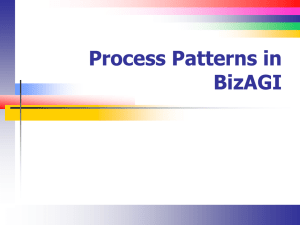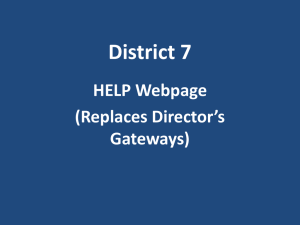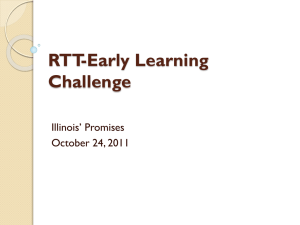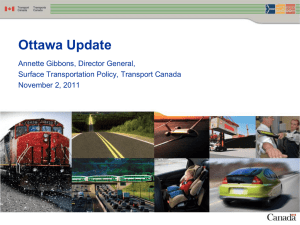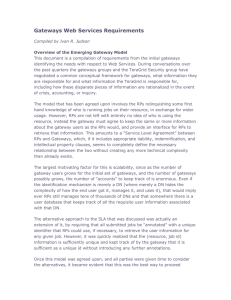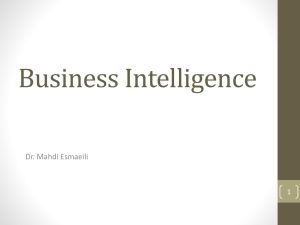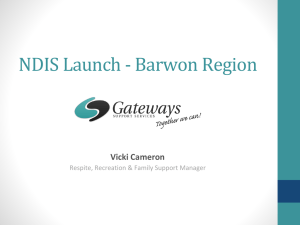- Figshare
advertisement
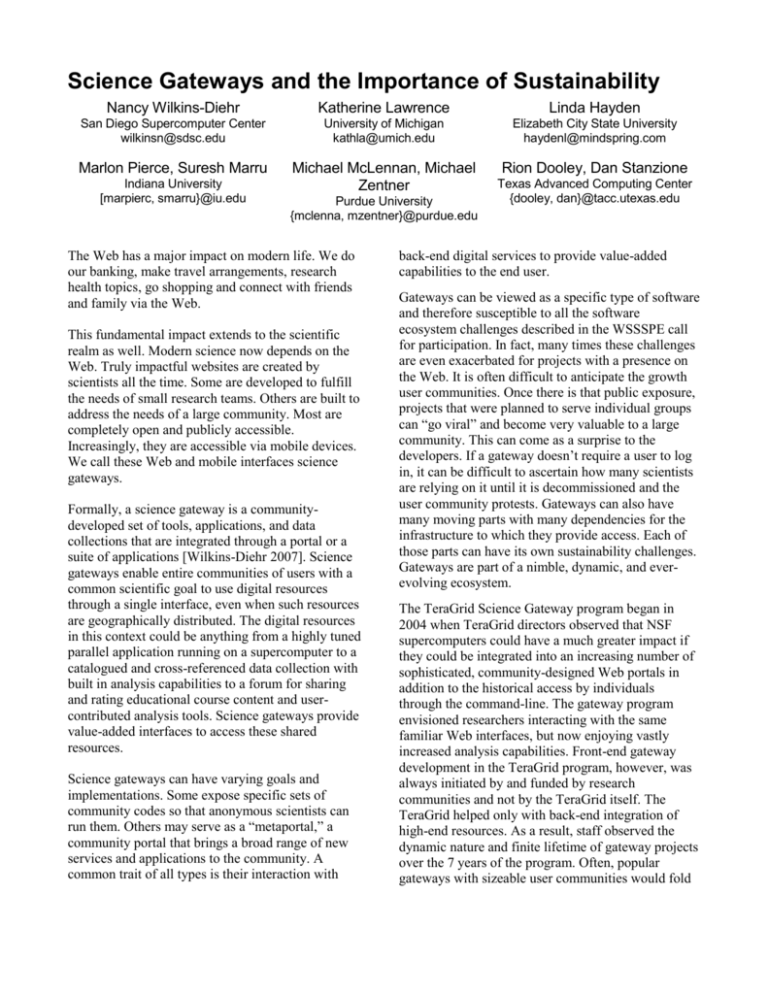
Science Gateways and the Importance of Sustainability
Nancy Wilkins-Diehr
Katherine Lawrence
Linda Hayden
San Diego Supercomputer Center
wilkinsn@sdsc.edu
University of Michigan
kathla@umich.edu
Elizabeth City State University
haydenl@mindspring.com
Marlon Pierce, Suresh Marru
Michael McLennan, Michael
Zentner
Indiana University
[marpierc, smarru}@iu.edu
Purdue University
{mclenna, mzentner}@purdue.edu
The Web has a major impact on modern life. We do
our banking, make travel arrangements, research
health topics, go shopping and connect with friends
and family via the Web.
This fundamental impact extends to the scientific
realm as well. Modern science now depends on the
Web. Truly impactful websites are created by
scientists all the time. Some are developed to fulfill
the needs of small research teams. Others are built to
address the needs of a large community. Most are
completely open and publicly accessible.
Increasingly, they are accessible via mobile devices.
We call these Web and mobile interfaces science
gateways.
Formally, a science gateway is a communitydeveloped set of tools, applications, and data
collections that are integrated through a portal or a
suite of applications [Wilkins-Diehr 2007]. Science
gateways enable entire communities of users with a
common scientific goal to use digital resources
through a single interface, even when such resources
are geographically distributed. The digital resources
in this context could be anything from a highly tuned
parallel application running on a supercomputer to a
catalogued and cross-referenced data collection with
built in analysis capabilities to a forum for sharing
and rating educational course content and usercontributed analysis tools. Science gateways provide
value-added interfaces to access these shared
resources.
Science gateways can have varying goals and
implementations. Some expose specific sets of
community codes so that anonymous scientists can
run them. Others may serve as a “metaportal,” a
community portal that brings a broad range of new
services and applications to the community. A
common trait of all types is their interaction with
Rion Dooley, Dan Stanzione
Texas Advanced Computing Center
{dooley, dan}@tacc.utexas.edu
back-end digital services to provide value-added
capabilities to the end user.
Gateways can be viewed as a specific type of software
and therefore susceptible to all the software
ecosystem challenges described in the WSSSPE call
for participation. In fact, many times these challenges
are even exacerbated for projects with a presence on
the Web. It is often difficult to anticipate the growth
user communities. Once there is that public exposure,
projects that were planned to serve individual groups
can “go viral” and become very valuable to a large
community. This can come as a surprise to the
developers. If a gateway doesn’t require a user to log
in, it can be difficult to ascertain how many scientists
are relying on it until it is decommissioned and the
user community protests. Gateways can also have
many moving parts with many dependencies for the
infrastructure to which they provide access. Each of
those parts can have its own sustainability challenges.
Gateways are part of a nimble, dynamic, and everevolving ecosystem.
The TeraGrid Science Gateway program began in
2004 when TeraGrid directors observed that NSF
supercomputers could have a much greater impact if
they could be integrated into an increasing number of
sophisticated, community-designed Web portals in
addition to the historical access by individuals
through the command-line. The gateway program
envisioned researchers interacting with the same
familiar Web interfaces, but now enjoying vastly
increased analysis capabilities. Front-end gateway
development in the TeraGrid program, however, was
always initiated by and funded by research
communities and not by the TeraGrid itself. The
TeraGrid helped only with back-end integration of
high-end resources. As a result, staff observed the
dynamic nature and finite lifetime of gateway projects
over the 7 years of the program. Often, popular
gateways with sizeable user communities would fold
because the 3-year research effort that funded them
had concluded.
These experiences led to a small EAGER study to
understand the characteristics of successful gateways
and the programs that fund them so that there could be
better planning from the start. “Fundamental
Cyberinfrastructure for Productive Science and
Engineering: Identification of Barriers to and Enablers
of Successful Projects” ran from 2009-2012. There
were 66 participants in five full-day focus groups on
the following topics:
Characteristics of successful gateways
Fields ready for transformation with
appropriate gateways in place
3. Research initiatives that have been
successful and sustainable in multiple
fields and through multiple funding
sources
4. External perspectives on the evaluation
criteria and compelling features of
potentially successful and sustainable
technology projects, and expert opinions
on the feasibility of new models for
sustaining science and engineering portals
and gateways
5. The viability of our preliminary findings
and identification of additional factors
and barriers that should be considered in
the implementation of any
recommendations emerging from this
study (This group included
representatives from NSF and other
federal agencies.)
1.
2.
Attendees came from leading organizations
worldwide, such as digital humanities projects,
astronomy gateways, citizen science projects, online
journals, and private foundations that evaluate
technology projects
(http://sciencegateways.org/projects/opening-sciencegateways-to-future-success/participants/). These focus
groups employed a many-to-many, participative
exchange of ideas and expertise among the
participants in order to generate practical insights that
drew on the strength of multidisciplinary perspectives.
We observed that millions of dollars are spent on
gateways, but developers face several challenges:
●
They often work in isolation even though
development can be quite similar across
domain areas.
● They bridge cyberinfrastructure — locally,
campus-wide, nationally, and sometimes
internationally.
● They need foundational building blocks so
they can focus on higher-level, grandchallenge functionality.
● They struggle to secure sustainable funding
because gateways span the worlds of research
and infrastructure.
The study outlined tensions in the academic
environment in which many science gateways are
developed. Gateways and perhaps other software
development efforts represent a partnership between
researchers in a science or engineering domain and
computer scientists. The domain researchers have a
vision of how technology can advance their basic
research challenges while the computer scientists can
be motivated by cutting-edge technology changes.
Sometimes these goals can be at odds [Lawrence,
2006]. Often there is little academic or financial
reward for maintaining a robust, reliable gateway
even if it enables thousands to be productive. This is
changing, but slowly. Academic leaders can also be
unprepared for the demands of production operation
and long-term planning.
The study concluded that gateways can significantly
increase research productivity, but designing the most
effective tools requires time and money, so we must
invest wisely. The impact of gateways can be
increased significantly if several key stakeholder
groups understand what makes the most successful
gateways successful. Recommendations are
summarized here, but are available in full in the report
[Wilkins-Diehr, Lawrence, 2012].
Recommendations for leadership and management
teams: design your governance to represent multiple
strengths and perspectives, plan for change and
turnover in the future, recruit a development team that
understands both the technical and domain-related
issues, consider how you will pay for the project after
the initial funding and measure success early and
often.
Recommendations for technology developers:
recognize the benefits and costs of hiring a team of
professionals, demonstrate your credibility through
stability and clarity of purpose (but remember to
match your end product to your goals), leverage the
work of others and plan for flexibility.
Recommendations related to outreach teams and
interested community members: identify an existing
community before you begin, make it clear what your
gateway is doing, know and show why your
community would want to participate, and enlist your
community to find solutions.
Recommendations to funding organizations: support
the lifecycle of technology projects, design
solicitations to elicit—and reward—effective business
plans, recognize the benefits and limitations of both
technology innovation and reuse, expect adjustments
during the production process, copy effective models
from other industries and sectors, and encourage
partnerships that support gateway sustainability
Successful gateways demonstrate value to large
numbers of constituents and keep operational costs
low. Because gateways can require a diverse set of
expertise to remain viable in the long term, providing
a pool of expertise that many can share can be a way
to reduce costs and reduce reinvention.
The Science Gateway Institute has proposed just such
a pool through a conceptualization award in NSF’s
Scientific Software Innovation Institutes (S2I2)
program. The goal of the institute is to not only serve
the National Science Foundation community, but
serve as a focal point for gateway development
nationally and internationally. In one example of
international cooperation, the Institute and the
International Workshop on Science Gateways will coedit a special journal issue featuring submissions from
workshops held by both groups.
The institute plans to offer several services and
resources to support the gateway development
community:
● An incubator service offering consultation
and resources on topics such as business plan
development, software engineering practices,
software licensing options, usability, security
and project management as well as a software
repository and hosting service.
●
A team of gateway developers to help
research groups build their own gateways.
● A forum to connect members of the
development community.
● A modular, layered framework that supports
community contributions and allows
developers to choose components.
● Workforce development to help train the next
generation for careers in this crossdisciplinary area and build pools of
institutional expertise that many projects can
leverage
Of course the institute itself needs to plan for
sustainability. How will other projects pay for
services? When does it make sense for NSF to fund
centralized services to make other projects cheaper to
launch? How does one measure success? How does
one design an organization that can evolve for the
long term? These questions and more will need to be
addressed in the strategic plan for the institute.
Many on the Science Gateway Institute team have had
long-term involvement in gateway projects and so
have their own experiences with sustainability. The
Center for Remote Sensing of Ice Sheets (CReSIS)
was established in 2005 to improve understanding of
polar ice sheet changes through improved
measurement and analysis. The last Intergovernmental
Panel on Climate Change (IPCC) Assessment was
unable to place an upper limit on sea-level rise
estimates, as a result of incomplete understanding of
ice sheets, so the need for a center clearly remains.
CReSIS plans to address sustainability by
strengthening partner relationships, increasing core
support from institutions involved, and developing
collaborative proposals (to NSF, NRL, NASA) by
identifying areas of important future work where the
center can contribute.
The Science Gateway Group at the Pervasive
Technology Institute at Indiana University has
worked with a great many gateways over the years.
The group observes that successful gateways have a
lot to teach other groups about sustainability. A wellestablished characteristic of any successful gateway is
that it has leadership willing to serve a community of
scientists over pursuing personal research
agendas. Many gateways also provide reproducibility
and transparency by tracking the provenance of a
user's online experiments in their data management
systems. This is a core capability of CIPRES,
UltraScan, GridChem, and QuakeSim gateways (to
name just a few).
Arguably more scientific application communities
should consider building gateways for these reasons:
they can provide a comprehensive “Software as a
Service” environment and relieve the burden on users
for installing and maintaining sometimes complicated
applications. Going beyond this, gateway
environments are excellent ways to measure impact of
software: the gateway can track who is using the
software, what (to some extent) they are doing with it,
and similar metrics. When gateways combine these
metrics with community building, they have the
potential to provide a stronger bond between
developers and users than other software delivery
approaches.
The HUBzero team observes that one approach to
making science gateways sustainable is to attract and
pool funding from multiple sources. HUBzero offers
a service model for science gateway support and
manages services through a recharge center where
many funded projects can leverage the expertise of a
common set of resources. Projects choose from a
well-defined menu of support services posted on the
hubzero.org web site, including hub operation
(hosting), web design, and consulting. Each service
has a fixed price established by Purdue University on
a cost-recovery basis. This recharge center supports
more than 27 projects from many different funding
agencies, including the US National Science
Foundation (NSF), the National Institute of Health
(NIH), the Department of Energy (DoE), the
Environmental Protection Agency (EPA), and some
private foundations. All together, this funding
supports a team of 25 staff working full time on the
HUBzero science gateway cyberinfrastructure project.
Pooling funding in this manner allows leveraging
efforts across multiple science gateway efforts. New
successful features created for one hub project are
integrated into the core software and thereby migrate
to all others, and to the HUBzero open source release.
For example, the collaborative “project” functionality
was originally developed for the Purdue University
Research Repository (purr.purdue.edu), and the
“collections” capability for finding and posting
interesting content was developed for
STEMEdHub.org. Wherever possible the HUBzero
team seeks to make such advances generic to drive
their adoption across the diverse set of gateways
based on HUBzero.
We hope these general and specific observations and
contribute to the discussion of the important topic of
software, and gateway, sustainability. Strides forward
in this area will benefit the research community in
many ways.
REFERENCES
[Lawrence, K. A. 2006] Walking the Tightrope: The
Balancing Acts of a Large e-Research Project.
Computer Supported Cooperative Work (CSCW): The
Journal of Collaborative Computing, 15(4): 385–411.
[Wilkins-Diehr 2007] Wilkins-Diehr, N. 2007.
Special issue: Science Gateways-- Common
Community Interfaces to Grid Resources: Editorials,
Journal of Concurrency in Computation: Practice
and Experience. Volume 19, Issue 6 (April 2007),
pages 743-749.
[Wilkins-Diehr, Lawrence, 2012] Wilkins-Diehr, N.
and Lawrence, K. A. 2012. Opening Science
Gateways to Future Success. Final report for the
National Science Foundation Grant Number OCI0948476, November 2012. Available for download at
http://sciencegateways.org/wpcontent/uploads/2012/06/Final_Report_OCI0948476.pdf].
